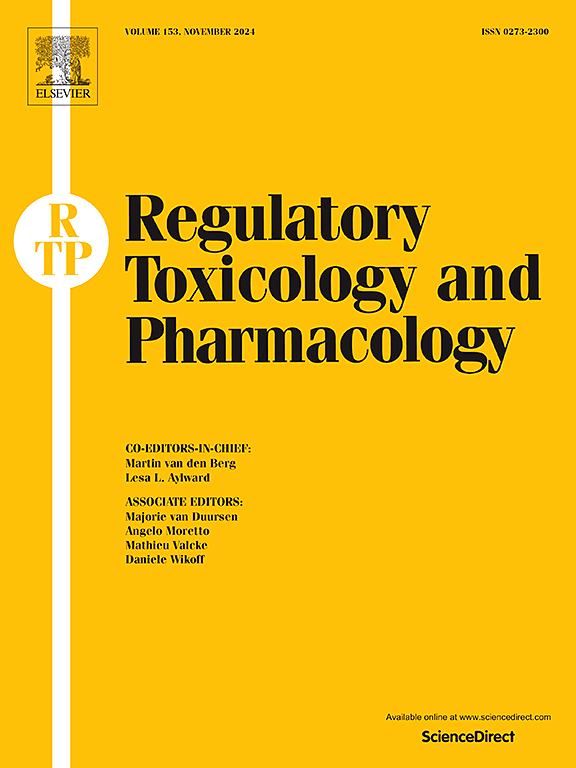Development of internal thresholds of toxicological concern (iTTC) for chemicals based on empirical exposures to pharmaceuticals
IF 3.5
4区 医学
Q1 MEDICINE, LEGAL
引用次数: 0
Abstract
The threshold of toxicological concern (TTC) is an approach to risk assessment that uses acceptable low-level exposure values derived from statistical information for chemicals for which insufficient toxicological information exists. Previously, the TTC for systemic toxicity was derived from the toxicological endpoints of the external dose for each administration route in animal studies. Internal TTC (iTTC), which extends the TTC concept from external to internal dosages, expands the scope of application by standardizing exposure via different routes. Information about blood exposure to pharmaceuticals used in treatment can help determine the chemical levels tolerated in humans. Using the tolerated plasma/serum blood drug concentration of the pharmaceutical as the toxicological point of departure, a new iTTC of 0.6 nM for the no effect concentration were proposed (a conservative risk assessment considers further safety margins). It is based on the 5th percentile values of the normal distribution, which approximates the cumulative empirical distribution, and an uncertainty coefficient to convert the treatment dose to the no-effect dose. Predicting blood concentrations of chemicals to which humans are exposed and comparing them to iTTC with appropriate caution can be used as an approach to risk assessment of systemic toxicity without animal-based testing.
根据对药物的经验接触制定化学品的毒理学关注的内部阈值
毒理学关注阈值(TTC)是一种风险评估方法,对毒理学信息不足的化学品使用从统计信息中得出的可接受的低水平接触值。以前,全身毒性的TTC是从动物研究中每种给药途径的外剂量的毒理学终点得出的。内部TTC (iTTC)将TTC概念从外部剂量扩展到内部剂量,通过标准化不同途径的暴露,扩大了TTC的适用范围。关于治疗中使用的药物的血液暴露信息可以帮助确定人体耐受的化学物质水平。以药物的耐受血浆/血清血药浓度为毒理学出发点,提出了一个新的无效应浓度的iTTC为0.6 nM(保守的风险评估考虑了进一步的安全边际)。它基于接近累积经验分布的正态分布的第5个百分位值和一个不确定系数将治疗剂量转换为无效应剂量。预测人类接触的化学物质的血液浓度,并适当谨慎地将其与iTTC进行比较,可作为一种无需动物试验的系统性毒性风险评估方法。
本文章由计算机程序翻译,如有差异,请以英文原文为准。
求助全文
约1分钟内获得全文
求助全文
来源期刊
CiteScore
6.70
自引率
8.80%
发文量
147
审稿时长
58 days
期刊介绍:
Regulatory Toxicology and Pharmacology publishes peer reviewed articles that involve the generation, evaluation, and interpretation of experimental animal and human data that are of direct importance and relevance for regulatory authorities with respect to toxicological and pharmacological regulations in society. All peer-reviewed articles that are published should be devoted to improve the protection of human health and environment. Reviews and discussions are welcomed that address legal and/or regulatory decisions with respect to risk assessment and management of toxicological and pharmacological compounds on a scientific basis. It addresses an international readership of scientists, risk assessors and managers, and other professionals active in the field of human and environmental health.
Types of peer-reviewed articles published:
-Original research articles of relevance for regulatory aspects covering aspects including, but not limited to:
1.Factors influencing human sensitivity
2.Exposure science related to risk assessment
3.Alternative toxicological test methods
4.Frameworks for evaluation and integration of data in regulatory evaluations
5.Harmonization across regulatory agencies
6.Read-across methods and evaluations
-Contemporary Reviews on policy related Research issues
-Letters to the Editor
-Guest Editorials (by Invitation)

 求助内容:
求助内容: 应助结果提醒方式:
应助结果提醒方式:


